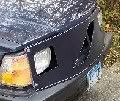|
I think that if you insert your ammeter (or multitester) between the battery [+] and the starter, you are completing a circuit thru the starter, and the ammeter is reading it. The starter of course will draw more like 50-100 amps or so if it can get it, but apparently it can only get 1/4 amp (250ma) with the ammeter in the circuit.
If you are - instead - probing on the starter's solenoid terminal, you are likely reading the solenoid's attempted current draw. Same story, but of course the solenoid draws far less current.
I'm sorry I don't know more about alternators and their diodes etc.
Hopefully others will chime in.
Maybe pull both red leads off the alternator, and then test the system for total current drain? I think I'd insert the meter between the battery + terminal and the car's + cable end. Or between the battery - and the car's ground cable end. With the cable removed from the battery, of course.
IF you find you need to replace the alternator, get a Bosch one, not a no-name generic. fcpgroton.com if you don't have a good source locally.
While changing the alt, replace the 3 rubber mount bushings. Two on the main mount bolt, and one at the base mount of the belt tension adjuster bracket. Most shops ignore the bushings, with the result that the alt. sits crooked and the belts run crooked across the pulleys. The part is cheap but pretty much requires removal of the alternator to change them.
--
Sven: '89 245, IPD sways, electric rad. fan conversion, 28+ mpg - auto tranny. 850 mi/week commute. '89 245 #2 (wifemobile). '90 244 (spare, runs).
|
